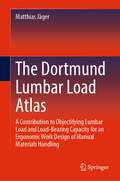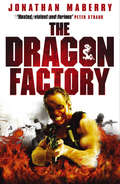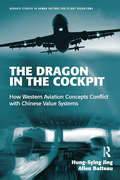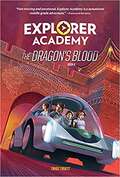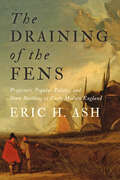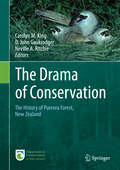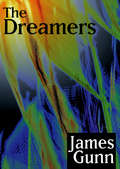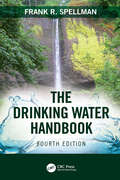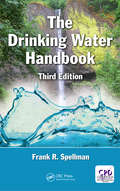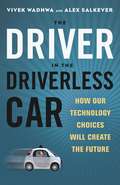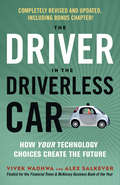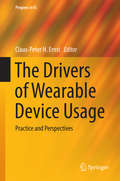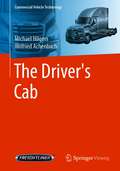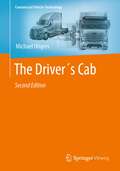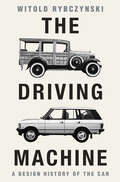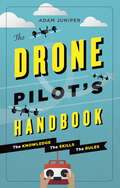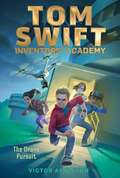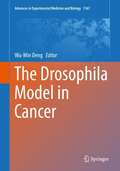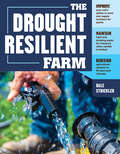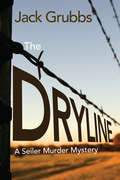- Table View
- List View
The Dortmund Lumbar Load Atlas: A Contribution to Objectifying Lumbar Load and Load-Bearing Capacity for an Ergonomic Work Design of Manual Materials Handling
by Matthias JägerThis handbook supports the identification of inappropriate work design in manual materials handling and thus the prevention of overloading the body and of the development of health disorders. The approach at hand, The Dortmund Lumbar Load Atlas, is focussed exclusively on biomechanical aspects of loading, overload criteria and signs of overloading in the form of verifiable low-back diseases due its strikingly frequently affectedness. Manual materials handling is understood to be the holding, lifting or lowering, pulling or pushing as well as carrying of load objects and thus the application of forces mostly with one or both hands on the item handled. Due to the biomechanical similarity, special handling tasks are also addressed, such as shoveling bulk material, transporting goods via wheelbarrow and moving people manually in the care sector. The book aims to promote interest in biomechanical approaches and provides information to all persons involved in the design, evaluation and redesign of manual materials handling, e.g. ergonomists, occupational physicians, orthopaedists, employers or researchers, lecturers and students. This handbook enables analysis of manual materials handlings regarding potential lumbar overload and contains the following:a comprehensive collection of data on lumbar load in typical manual materials handling activities—a load register on interbranch activities,synopses of previously analysed biomechanically challenging occupational activities—a load register on branch-specific activities,explanations of the methodological approach to predicting moments and forces as well as their components in relation to the lumbar spine via biomechanical modelling andcriteria for the evaluation of load data with regard to potential lumbar overloading during single operations, working shifts and the entire occupational life. The new recommendations on maximum daily exposure for lifelong work for both men and women are bridging the former gap of biomechanically justified action frequency limits and now offer the possibility of a completely biomechanical path for risk assessment of manual materials handling. The book provides hence a serious contribution to the objectification of lumbar load and load-bearing capacity aiming at an ergonomic work design of manual materials handling for short- as well as long-term exposures.
The Dr. Wu Brain Switcheroo!: An Adventure with a Physics Phenom
by Jared SamsWhen Qianna creates a device that can link people with their favorite figures throughout history, Quinn can’t wait to use it. He wants to learn a thing or two from Dr. Chien-Shiung Wu in time for an upcoming science test. But something goes awry, causing Quinn and the genius doc to find themselves swapped in time. Can Qianna and the QTs reverse the brain switcheroo before Quinn becomes trapped in the past? Find out in a dynamic graphic novel that gives science, engineering, and invention a hip-hop spin!
The Dr. Wu Brain Switcheroo!: An Adventure with a Physics Phenom
by Jared SamsWhen Qianna creates a device that can link people with their favorite figures throughout history, Quinn can’t wait to use it. He wants to learn a thing or two from Dr. Chien-Shiung Wu in time for an upcoming science test. But something goes awry, causing Quinn and the genius doc to find themselves swapped in time. Can Qianna and the QTs reverse the brain switcheroo before Quinn becomes trapped in the past? Find out in a dynamic graphic novel that gives science, engineering, and invention a hip-hop spin!
The Dr. Wu Brain Switcheroo!: An Adventure with a Physics Phenom (Qianna and the Quantum Train)
by Jared SamsWhen Qianna creates a device that can link people with their favorite figures throughout history, Quinn can’t wait to use it. He wants to learn a thing or two from Dr. Chien-Shiung Wu in time for an upcoming science test. But something goes awry, causing Quinn and the genius doc to find themselves swapped in time. Can Qianna and the QTs reverse the brain switcheroo before Quinn becomes trapped in the past? Find out in a dynamic graphic novel that gives science, engineering, and invention a hip-hop spin!
The Dragon Factory
by Jonathan MaberryHaving protected the world from a zombie plague in PATIENT ZERO, Joe Ledger and his crack Department of Special Sciences combat team are thrown into an even more frightening crisis.A genetic-engineering program has been used to create the ultimate fighting machine - soldiers bred for war, soldiers with greater strength, higher reaction speeds and an utter disregard for pain. Theirs and others.It's a nightmare from the pages of Doctor Moreau and soon Joe and his team are up against both the big business concerns who have billions invested in the project and, on the street, adversaries bred expressly to kill them. It's enough to make you wish you were facing zombies again ...
The Dragon in the Cockpit: How Western Aviation Concepts Conflict with Chinese Value Systems (Ashgate Studies in Human Factors for Flight Operations)
by Hung Sying Jing Allen BatteauThe purpose of The Dragon in the Cockpit is to enhance the mutual understanding between Western aviation human-factors practitioners and the Chinese aviation community by describing some of the fundamental Chinese cultural characteristics pertinent to the field of flight safety. China’s demand for air transportation is widely expected to increase further, and the Chinese aviation community are now also designing their own commercial aircraft, the COMAC C-919. Consequently, the interactions in the air between the West and China are anticipated to become far more extensive and dynamic. However, due to the multi-faceted nature of Chinese culture, it is sometimes difficult for Westerners to understand Chinese thought and ways, sometimes to the detriment of aviation safety. This book provides crucial insights into Chinese culture and how it manifests itself during flight operations, as well as highlighting ways in which Western technology and Chinese culture clash within the cockpit. Science and technology studies (STS) have demonstrated that sophisticated technologies embed cultural assumptions, usually in subtle ways. These cultural assumptions 'bite back' when the technology is used in an unfamiliar cultural context. By creating the insider’s perspective on the cultural/technological assumptions of the world’s fastest growing industrial economy, this book seeks to minimize the accidents and damage resulting from technological/cultural misunderstandings and misperceptions.
The Dragon's Blood (Explorer Academy #6)
by National Geographic KidsAn explosive revelation and a familiar face heighten the mystery for Cruz and friends in the sixth book in this adventure-packed series. Still reeling from the life-changing discovery he found buried in the mysterious archive, Cruz Coronado grapples with an important secret as the gang heads to China in search of the second-to-last piece of the cipher. Under the watchful eye of a new adviser, life on the ship returns to almost normal...Almost. Just as things seem to be going smoothly, a familiar face shocks Cruz back into reality, and the final piece in this life-and-death scavenger hunt veers toward a dead end. Explorer Academy features: Gripping fact-based fiction plot that inspires curiosity with new technology and innovations; amazing inventions and gadgets; a cast of diverse, relatable characters; secret clues, codes, and ciphers to track down within the text; vibrant illustrations, Elements of STEAM; National Geographic explorer profiles in The Truth Behind Section.
The Draining of the Fens: Projectors, Popular Politics, and State Building in Early Modern England (Johns Hopkins Studies in the History of Technology)
by Eric H. AshHow landowners, drainage projectors, and investors worked with the Crown to transform England's waterlogged Fens.2017 Choice Outstanding Academic TitleThe draining of the Fens in eastern England was one of the largest engineering projects in seventeenth-century Europe. A series of Dutch and English "projectors," working over several decades and with the full support of the Crown, transformed hundreds of thousands of acres of putatively barren wetlands into dry, arable farmland. The drainage project was also supposed to reform the sickly, backward fenlanders into civilized, healthy farmers, to the benefit of the entire commonwealth. As projectors reconstructed entire river systems, these new, artificial channels profoundly altered both the landscape and the lives of those who lived on it. In this definitive account, historian Eric H. Ash provides a detailed history of this ambitious undertaking. Ash traces the endeavor from the 1570s, when draining the whole of the Fens became an imaginable goal for the Crown, through several failed efforts in the early 1600s. The book closes in the 1650s, when, in spite of the project's enormous difficulty and expense, the draining of the Great Level of the Fens was finally completed. Ash ultimately concludes that the transformation of the Fens into fertile farmland had unintended ecological consequences that created at least as many problems as it solved.Drawing on painstaking archival research, Ash explores the drainage from the perspectives of political, social, and environmental history. He argues that the efficient management and exploitation of fenland natural resources in the rising nation-state of early modern England was a crucial problem for the Crown, one that provoked violent confrontations with fenland inhabitants, who viewed the drainage (and accompanying land seizure) as a grave threat to their local landscape, economy, and way of life. The drainage also reveals much about the political flash points that roiled England during the mid–seventeenth century, leading up to the violence of the English Civil War. This is compelling reading for British historians, environmental scholars, historians of technology, and anyone interested in state formation in early modern Europe.
The Drama of Conservation
by Carolyn M. King D. John Gaukrodger Neville A. RitchieThis book offers a sweeping history of Pureora Forest Park, one of the most significant sites of natural and cultural history interest in New Zealand. The authors review the geological history of the volcanic zone, its flora and fauna, and the history of Maori and European utilization of forest resources. Chapter-length discussions cover management of the native forest by the New Zealand Forest Service; the forest village and its sawmills; the intensive timber harvesting, and the conflicts with conservationists and expensive compensation agreements that ensued. Separate chapters cover initiatives to protect the forest from introduced herbivores; to guard protected species, especially birds, from predators; the facilities for recreational hunting; the development of the Timber Trail, an 83 km cycleway through the forest and along old logging tramways, complete with detailed interpretation signs illustrating the history of logging; and the family recreation areas and tracks. The final chapter gathers conclusions and advances prospects for the future of Pureora Forest. In sum, the book demonstrates how ecological study, combined with a respect for people and for nature plus a flexible, interdisciplinary approach to both local history and current scientific priorities, can be welded into a consistently effective strategy for addressing the pressing forest-ecology questions of our time.
The Dreamers
by James GunnIt is an age when high tech rules supreme. Computers do all the work while humans spend their lives enjoying drug-induced fantasies. Only a handful live and work in the traditional sense--managing the few affairs that still need attention. At the center of this system is the Mnemonist, the man who directs everything that happens. But now he has reached an advanced age and must carefully choose a dreamer capable of taking over his crucial position.
The Drinking Water Handbook
by Frank R. SpellmanThis new edition of The Drinking Water Handbook is thoroughly revised and updated and includes a comprehensive discussion of "forever chemicals," as well as the herbicide atrazine in drinking water. It presents the latest coverage of contaminants in water, such as personal care products and pharmaceuticals (PCPPs) and endocrine disruptors, and examines the security requirements for waterworks and ancillary procedures. It examines the process of producing drinking water— from sources of water, to the purification process, through distribution systems to the tap, and then to the actual use and reuse of water. It also presents the latest advancements in treatment technologies and reviews new laws and regulations related to drinking water as well. Thoroughly revised and updated, including a comprehensive discussion of the Flint, Michigan, lead contamination event. Offers a systematic, easy-to-understand explanation of the many processes employed to make water safe to drink. Examines what is being done to mitigate growing concerns about disinfection by-products and PPCPs in water. Provides coverage of individual contaminants found in water. Investigates the physical, chemical, and microbiological parameters that must be modified to produce potable water.
The Drinking Water Handbook
by Frank SpellmanThis new edition of The Drinking Water Handbook is thoroughly revised and updated, and includes a comprehensive discussion of the Flint, Michigan lead contamination event, new coverage of contaminants in water, such as personal care products and pharmaceuticals (PCPP) and endocrine disruptors, and examines the security requirements for waterworks and ancillary procedures. It examines the process of producing drinking water— from sources of water, to the purification process, through distribution systems to the tap, and then to the actual use and reuse of water. It also reflects the latest advancements in treatment technologies and reviews new laws and regulations related to drinking water.
The Driver in the Driverless Car: How Our Technology Choices Will Create the Future
by Vivek Wadhwa Alex SalkeverA computer beats the reigning human champion of Go, a game harder than chess. Another is composing classical music. Labs are creating life-forms from synthetic DNA. A doctor designs an artificial trachea, uses a 3D printer to produce it, and implants it and saves a child's life.Astonishing technological advances like these are arriving in increasing numbers. Scholar and entrepreneur Vivek Wadhwa uses this book to alert us to dozens of them and raise important questions about what they may mean for us.Breakthroughs such as personalized genomics, self-driving vehicles, drones, and artificial intelligence could make our lives healthier, safer, and easier. But the same technologies raise the specter of a frightening, alienating future: eugenics, a jobless economy, complete loss of privacy, and ever-worsening economic inequality. As Wadhwa puts it, our choices will determine if our future is Star Trek or Mad Max. Wadhwa offers us three questions to ask about every emerging technology: Does it have the potential to benefit everyone equally? What are its risks and rewards? And does it promote autonomy or dependence? Looking at a broad array of advances in this light, he emphasizes that the future is up to us to create—that even if our hands are not on the wheel, we will decide the driverless car's destination.
The Driver in the Driverless Car: How Your Technology Choices Create the Future
by Vivek Wadhwa Alex SalkeverTech experts Vivek Wadhwa and Alex Salkever describe dozens of astonishing technological advances in this fascinating and thought-provoking book, which asks what kind of future lies ahead—Star Trek or Mad Max? Breakthroughs such as personalized genomics, drones, self-driving vehicles, and artificial intelligence could make our lives healthier, safer, and easier. On the other hand, the same technologies raise the specter of a frightening future—eugenics, a jobless economy, a complete loss of privacy, and ever-worsening economic inequality. Wadhwa says that we need to ask three questions about every emerging technology: Does it have the potential to benefit everyone equally? What are the risks and the rewards? And does it promote autonomy or dependence? This edition is updated throughout and includes a new chapter on quantum computing, which promises vastly increased processing times—and vastly increased security risks. In the end, our future is up to us; our hands may not be on the wheel, but we will decide the driverless car's destination.
The Drivers of Wearable Device Usage
by Claus-Peter H. ErnstThisbook collects multiple research articles studying the factors influencing wearabledevice usage. Based on multiple empirical studies, which research differentkinds of wearable devices such as smartwatches, activity trackers, andsmartglasses, potential drivers of wearable device usage are identified andevaluated. Overall, the book provides novel and important insights for bothpractitioners and academics, highlights their various practical implicationsfor the development and marketing of wearable devices and offers outlooks onfurther research directions.
The Driver´s Cab (Commercial Vehicle Technology)
by Michael Hilgers Wilfried AchenbachThe aim of this work, consisting of 9 individual, self-contained booklets, is to describe commercial vehicle technology in a way that is clear, concise and illustrative. Compact and easy to understand, it provides an overview of the technology that goes into modern commercial vehicles. Starting from the customer's fundamental requirements, the characteristics and systems that define the design of the vehicles are presented knowledgeably in a series of articles, each of which can be read and studied on their own. In this volume, The Driver's Cab, the vehicle cab is reviewed in simple terms for the layman. The three functions it must support, driving, living and sleeping and the features of the cab equipment provided therefor are presented. Important systems of the driver's cab are discussed in readily understandable terms.
The Driver´s Cab (Commercial Vehicle Technology)
by Michael HilgersThe aim of this work, consisting of 9 individual, self-contained booklets, is to describe commercial vehicle technology in a way that is clear, concise and illustrative. Compact and easy to understand, it provides an overview of the technology that goes into modern commercial vehicles. Starting from the customer's fundamental requirements, the characteristics and systems that define the design of the vehicles are presented knowledgeably in a series of articles, each of which can be read and studied on their own. In this volume, The Driver's Cab, the vehicle cab is reviewed in simple terms for the layman. The three functions it must support, driving, living and sleeping and the features of the cab equipment provided therefor are presented. Important systems of the driver's cab are discussed in readily understandable terms.
The Driving Machine: A Design History of the Car
by Witold RybczynskiThe renowned design writer on the extraordinary history of car design. In this lively and entertaining work, Witold Rybczynski—hailed as “one of the best writers on design working today” by Publishers Weekly—tells the story of the most distinctive cars in history and the artists, engineers, dreamers, and gearheads who created them. Delving into more than 170 years of ingenuity in design, technology, and engineering, he takes us from Carl Benz’s three-wheel motorcar in 1855 to the present-day shift to electric cars. Along the way, he looks at the emergence of mass production with Henry Ford’s Model T; the Golden Age of American car design and the rise of car culture; postwar European subcompacts typified by the Mini Cooper; and the long tradition of the streamlined and elegant sports car. Rybczynski explores how cars have been reflections of national character (the charming Italian Fiat Cinquecento), icons of a subculture (the VW bus for American hippies), and even emblems of an era (the practical Chrysler minivan). He explains key developments in automotive technology, including the electric starter, rack-and-pinion steering, and disc brakes, bringing to light how the modern automobile is the result of more than a century of trial and error. And he weaves in charming accounts of the many cars he’s owned and driven, starting with his first—the iconic Volkswagen Beetle. The Driving Machine is a breezy and fascinating history of design, illustrated with the author’s delightful drawings.
The Drone Pilot's Handbook
by Adam JuniperThe perfect companion for anyone buying (or thinking of buying) a drone, whether it's just for fun, to race against friends, or to give their to give their photography a whole new angle.The Drone Pilot's Handbook gives you the skills and techniques you need to fly and maintain your multicopter drone, tips for tuning it for maximum performance, and - importantly - a clear graphical guide to where the law will and won't allow you to fly. Meanwhile, spectacular aerial photography from around the world will inspire you to get airborne immediately!Occasional boxouts provide safety tips, handy ideas, and URLs, and flying instructions are presented with attractive original illustrations. This clean approach that makes a welcome contrast to ugly online forums, or the PDFs that drone manufacturers provide, and will have you up and away in no time.
The Drone Pursuit (Tom Swift Inventors' Academy #1)
by Victor AppletonThe Hardy Boys meets Alex Rider in this start to a brand-new series starring everyone’s favorite inventor—Tom Swift!When your dad funds the Swift Academy of Science and Technology, you’re bound to have a bunch of tech at your disposal. So no one bats an eye when Tom and his best friend, Noah, test their new virtual reality drone before class. At the academy, once class starts and the drone is parked, their brainiac friends then launch into farfetched discussions about the curriculum. And when they watch a documentary about the FBI’s most wanted hackers from the eighties, they quickly start speculating that the academy custodian is one of them. At first, Tom dismisses the idea as another one of his friends’ conspiracy theories. But using their new drone, he spies the custodian acting suspiciously around school. As Tom and his friends search for evidence that the custodian is the missing hacker, the signs become impossible to ignore when Tom gets threatening messages that warn him away from investigating. And when someone releases a virus in the school servers, all bets are off as the adjoining servers at tech giant Swift Enterprises come under fire. Can Tom and his friends uncover the true culprit before it’s too late?
The Drosophila Model in Cancer (Advances in Experimental Medicine and Biology #1167)
by Wu-Min DengThis volume provides a series of review articles that capture the advances in using the fruit fly, Drosophila melanogaster, model system to address a wide range of cancer-related topics. Articles in this book provide case studies that shed light on the intricate cellular and molecular mechanisms underlying tumor formation and progression. Readers will discover the beauty of the fly model’s genetic simplicity and the vast arsenal of powerful genetic tools enabling its efficient and adaptable use. This model organism has provided a unique opportunity to address questions regarding cancer initiation and development that would be extremely challenging in other model systems. This book provides a useful resource for a researcher who wishes to learn about and apply the Drosophila model to tackle fundamental questions in cancer biology, and to find new ways to fight against this devastating disease.
The Drought-Resilient Farm: Improve Your Soil’s Ability to Hold and Supply Moisture for Plants; Maintain Feed and Drinking Water for Livestock when Rainfall Is Limited; Redesign Agricultural Systems to Fit Semi-arid Climates
by Dale StricklerRainfall levels are rarely optimal, but there are hundreds of things you can do to efficiently conserve and use the water you do have and to reduce the impact of drought on your soil, crops, livestock, and farm or ranch ecosystem. Author Dale Strickler introduces you to the same innovative systems he used to transform his own drought-stricken family farm in Kansas into a thriving, water-wise, and profitable enterprise, maximizing healthy cropland, pasture, and water supply. Ranging from simple, short-term projects such as installing rain-collection ollas to long-term land-management planning strategies, Strickler’s methods show how to get more water into the soil, keep it in the soil, and help plants and livestock access it. This publication conforms to the EPUB Accessibility specification at WCAG 2.0 Level AA.
The Dry Forests and Woodlands of Africa: Managing for Products and Services (The Earthscan Forest Library)
by Emmanuel N. Chidumayo Davison J. GumboThe dry forests and woodlands of Sub-Saharan Africa are major ecosystems, with a broad range of strong economic and cultural incentives for keeping them intact. However, few people are aware of their importance, compared to tropical rainforests, despite them being home to more than half of the continent's population. This unique book brings together scientific knowledge on this topic from East, West, and Southern Africa and describes the relationships between forests, woodlands, people and their livelihoods. Dry forest is defined as vegetation dominated by woody plants, primarily trees, the canopy of which covers more than 10 per cent of the ground surface, occurring in climates with a dry season of three months or more. This broad definition - wider than those used by many authors - incorporates vegetation types commonly termed woodland, shrubland, thicket, savanna, wooded grassland, as well as dry forest in its strict sense. The book provides a comparative analysis of management experiences from the different geographic regions, emphasizing the need to balance the utilization of dry forests and woodland products between current and future human needs. Further, the book explores the techniques and strategies that can be deployed to improve the management of African dry forests and woodlands for the benefit of all, but more importantly, the communities that live off these vegetation formations. Thus, the book lays a foundation for improving the management of dry forests and woodlands for the wide range of products and services they provide.
The Dryline: A Seiler Murder Mystery (The Seiler Murder Mysteries #2)
by Jack GrubbsAn engineer gets caught in the gears of a deadly conspiracy in this thriller of new technology and ruthless oilmen set in Luling, Texas.Once known as the “Toughest Town in Texas,” Luling is about to see a whole new kind of trouble when oil money and murder collide. Former NASA engineer Tom Seiler has been helping his brother, Don, with a new oil extraction system potentially worth billions. But when a worker is found dead on the outskirts of Luling, the brothers find themselves up against a group of ruthless oilmen bent on stealing their design.Surrounded by danger, Tom and Don have no option but to ?ght for the system—and their lives. Set among the rolling hills of South Texas, The Dryline explores the vagaries of nature, the one-of-a-kind Luling Watermelon Thump, and the struggle between justice and revenge.
